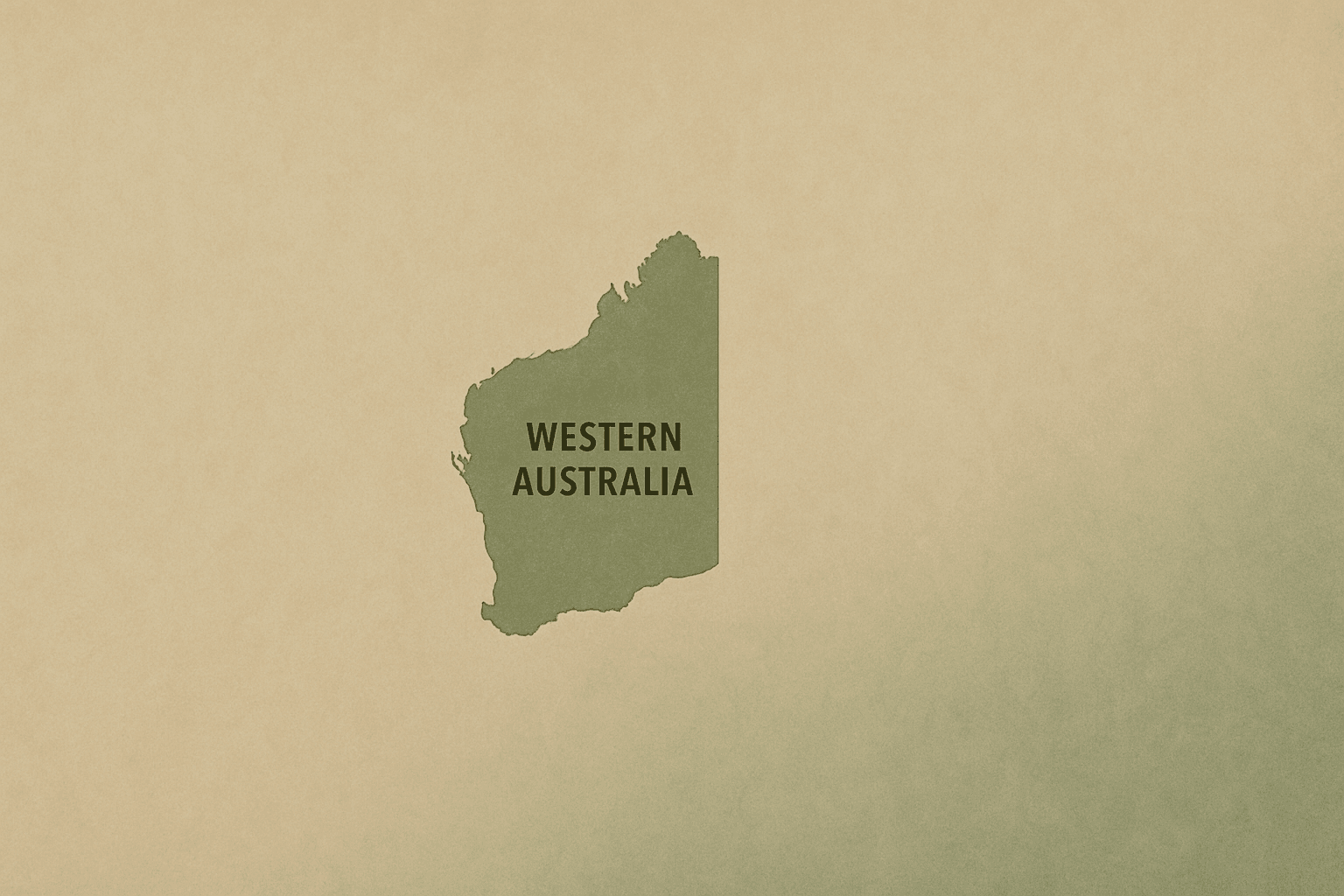Last Updated on October 3, 2025
Ever wondered if a place could actually live up to those perfect, postcard-like photos you see online? I get it. After years of exploring WA in my campervan, I’ve learned that some spots are just hype. But I can tell you, Cape Le Grand National Park is the real deal. It’s where you’ll find those impossibly white beaches, friendly kangaroos, and granite peaks that seem to tumble into the turquoise ocean. It’s one of my absolute favourite places to come back to, time and time again.
If you’re planning a trip to the Esperance area, this park isn’t just a “nice to see”, it’s a must-do. I’m going to walk you through everything you need to know, from the best beaches and hikes to where you can set up camp. Think of me as your friendly guide, sharing all the little tips I’ve picked up on the road to make your visit smooth, safe, and truly unforgettable.
Here’s a quick look at what makes this place so special:
- World-Famous Beaches: Home to Lucky Bay, officially one of the best beaches on the planet, complete with resident sunbathing kangaroos.
- Epic Hikes: From the challenging climb up Frenchman Peak for panoramic views to the stunning 20km Cape Le Grand Coastal Trail.
- Stunning Scenery: Ancient granite landscapes meet crystal-clear waters of the Recherche Archipelago.
- Awesome Camping: Two well-equipped campgrounds let you wake up to the sound of the ocean, but you need to book well in advance!
A Landscape Shaped by Time
The landscape at Cape Le Grand feels ancient, and that’s because it is. The park’s famous granite peaks, like Frenchman Peak and Mount Le Grand, are part of the Yilgarn Craton, one of the oldest exposed rock formations on Earth. These rocks were formed during the Precambrian era over 600 million years ago.
These huge domes, smoothed over by millions of years of wind and rain, create a beautiful contrast against the park’s pure white beaches and bright blue waters. To the local Nyungar and Ngadju peoples, this land holds deep cultural significance.
The coastline is a stunning series of bays and rocky headlands, each with its own incredible view of the Southern Ocean. As you move inland, the scenery shifts from coastal heath to woodlands, creating a diverse home for wildlife that has adapted to this remote corner of Australia.
World-Class Beaches
It’s no exaggeration to say that the beaches in Cape Le Grand National Park are among the best in the world. They are the main reason so many people make the trip here.
Lucky Bay
You’ve probably seen the photos, and they’re all true. Lucky Bay became world-famous when it was named the best beach on the planet in 2023 by a panel of travel professionals for Banana Boat’s “World’s 50 Best Beaches”. The sand is so fine and white it actually squeaks under your feet.
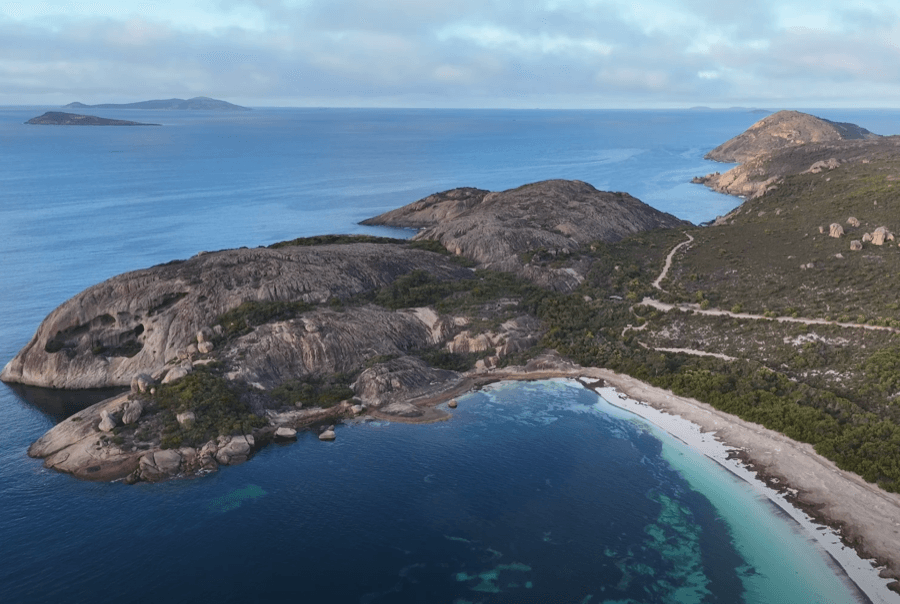
Of course, what makes it truly special are the local western grey kangaroos. They love to hang out on the sand, creating one of Australia’s most iconic photo opportunities. A pro-tip I always share is to visit early in the morning or late afternoon for the best chance to see them when they are most active.
The bay’s calm, protected waters are perfect for swimming and snorkelling, and the long shoreline is ideal for a stroll with the distant islands of the Recherche Archipelago on the horizon.
Hellfire Bay
Don’t let the name fool you, Hellfire Bay is pure paradise. This beautiful crescent-shaped beach is framed by large, rounded granite boulders that create a kind of natural amphitheatre. The colours here are incredible, with the bright blue water contrasting against the orange-tinted rocks, especially at sunrise or sunset.
There’s a great picnic area here with gas barbecues and sheltered tables, making it the perfect spot to stop for lunch while soaking in the amazing scenery.
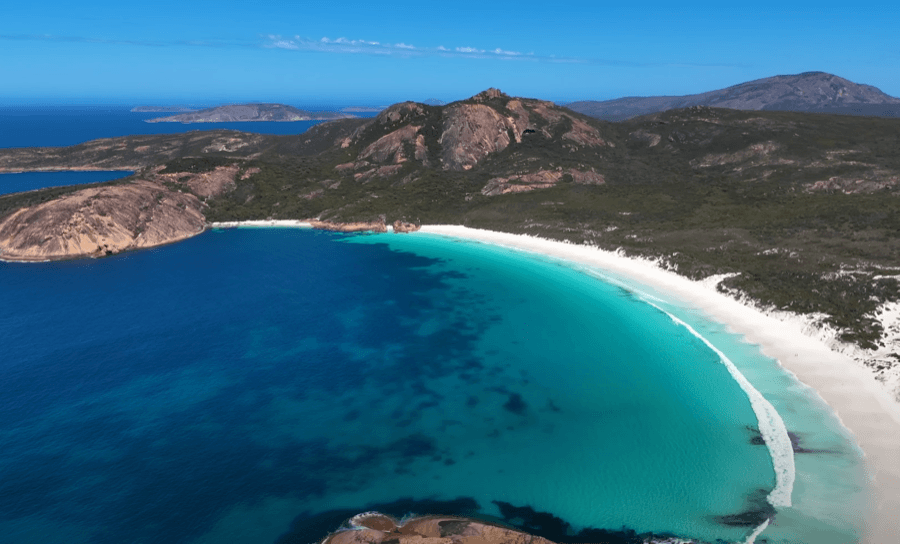
Thistle Cove
Just a quick drive from Hellfire Bay, you’ll find the beautiful and dramatic Thistle Cove. It’s home to the famous “Whistling Rock,” a large granite boulder that creates whistling sounds as the sea breeze funnels through its cracks. It’s a really unique natural feature to experience.
The cove is surrounded by impressive boulder formations, and because it’s a little more secluded, you might even get to enjoy this stunning spot all to yourself.
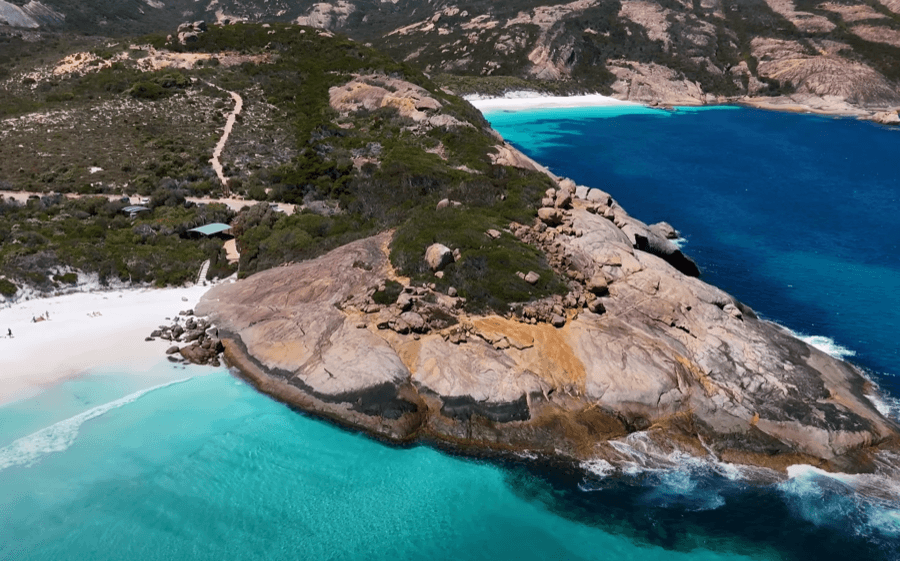
Le Grand Beach
Le Grand Beach is a bit different from the park’s sheltered coves. This long, sweeping beach stretches for over 20 kilometres and is a popular spot for 4WD beach driving and fishing. It gives you a real sense of the vastness of the coastline here.
Tucked away behind the dunes is the Le Grand Beach Campground, which offers one of the most amazing beachfront camping experiences you can find anywhere in Australia.
Lesser-Known Treasures
Beyond the famous spots, Cape Le Grand has a few hidden gems that are well worth the effort:
- Little Hellfire Bay: You can reach this private cove via a 40-minute return walk from Hellfire Bay. It’s the perfect spot if you’re looking for some peace and quiet.
- Rossiter Bay: Located near the park’s western entrance, this beach is much quieter and fantastic for birdwatching. After a storm, it’s also a great place for collecting unique shells.
- Warton Beach: A favourite with local surfers, this eastern beach has some great breaks and a rugged, wild beauty beneath its tall coastal bluffs.
- Dunn Rocks: This spot on the eastern side of the park is popular for fishing and requires a 4WD to access. It offers a more off-the-beaten-path experience.
Trails Through Time: Cape Le Grand Hikes
Cape Le Grand offers some of the best hiking in WA, with everything from short walks to challenging coastal treks.
Frenchman Peak Trail
The hike up Frenchman Peak, or Mandooboornup as it’s known by the local Indigenous people, is a must-do. It stands at 262 metres and the 3-kilometre return trip is steep and challenging, so I’d allow about two hours. It has a Grade 5 difficulty rating, which means it’s for experienced hikers with a good level of fitness as it involves climbing up steep, smooth rock faces.
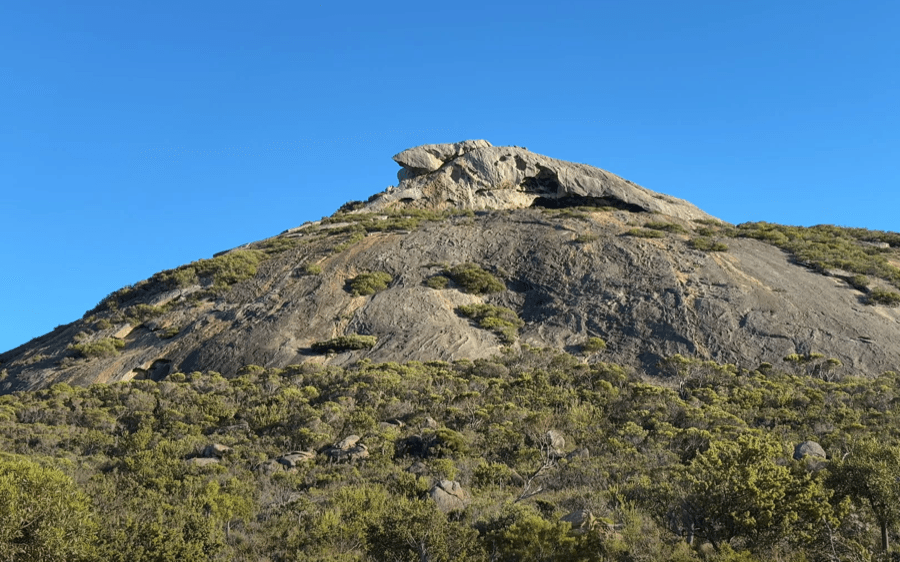
The trail markers lead you up the granite slope to the summit, where you’re rewarded with absolutely incredible panoramic views across the park and out to the Recherche Archipelago. Near the top, there’s a large cave-like arch that offers a fantastic frame for your photos. A word of warning from my own experience, avoid this hike in wet or windy weather, as the rock becomes extremely slippery and dangerous.
Cape Le Grand Coastal Trail
For those looking for a bigger challenge, the 20-kilometre Cape Le Grand Coastal Trail is an unforgettable experience. The trail connects Rossiter Bay to Le Grand Beach, taking you through all the diverse landscapes the park has to offer. You’ll walk across beaches, over granite headlands, and through beautiful coastal heath.
While you can tackle it in one long day, I recommend breaking it into smaller sections. The trail has vehicle access points at most of the main bays. Here’s a quick breakdown:
- Rossiter Bay to Lucky Bay (6.6km, 2-3 hours): A moderate hike that rewards you with your first stunning view of Lucky Bay.
- Lucky Bay to Thistle Cove (2.5km, 1 hour): This is the easiest and a very popular section with amazing views out to the islands.
- Thistle Cove to Hellfire Bay (4.7km, 2-3 hours): A harder section with steep granite climbs that can be slippery when wet.
- Hellfire Bay to Le Grand Beach (6.2km, 3 hours): The most demanding part of the trail with some challenging climbs and descents.
Wildlife Encounters
Because Cape Le Grand is so remote, it’s a real sanctuary for native Australian animals. It provides a fantastic opportunity to see wildlife in a natural setting.
The most famous residents are the western grey kangaroos at Lucky Bay, who are very used to people and can often be seen relaxing on the beach. But there’s plenty more to see. In the heathlands, you might be lucky enough to spot smaller animals like pygmy possums and southern brown bandicoots, also known as quenda.
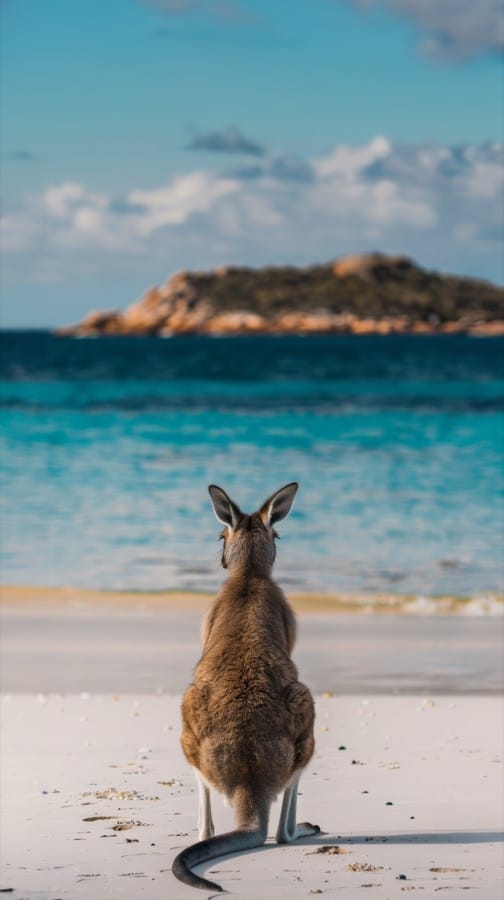
The park is also a paradise for birdwatchers, with over 110 species recorded. Look to the skies for white-bellied sea eagles soaring overhead, and keep an eye out for colourful Southern Emu-wrens and Rock Parrots in the heath.
The marine life is just as impressive. It’s common to see bottlenose dolphins playing in the bays. During their annual migration between May and October, you might even spot Southern right whales passing by offshore.
A Botanical Paradise
If you visit in the spring, you’re in for a real treat. The park explodes with colour as wildflowers carpet the landscape. The plants here have cleverly adapted to the tough coastal conditions and sandy soils.
The coastal heath is full of a huge variety of species, including the showy banksia (*Banksia speciosa*), hakeas, and grevilleas. The park is also known for its beautiful and rare orchids, which appear after the winter rains. One of the stars of the show is the endemic qualup bell, which has vibrant orange flowers and is one of WA’s most unique floral emblems.
Camping Under Southern Stars
There’s nothing quite like camping right by the coast, and Cape Le Grand has two fantastic campgrounds that let you do just that.
Lucky Bay Campground
The Lucky Bay Campground has been upgraded and offers 56 sites suitable for tents, camper trailers, and caravans. The facilities are great, with solar-heated showers, modern toilets, and camp kitchens with gas barbecues. Being so close to the famous beach means you can go for a sunrise walk or see the kangaroos in the evening, just a few steps from your campsite.
Sometimes you can even grab a fresh coffee in the morning from the Lucky Bean Café van that parks up on the beach.
Bookings can be made up to 6 months in advance through the official website, and I highly recommend you book well in advance if you are planning on heading over there during peak season!
Le Grand Beach Campground
This campground is smaller and more intimate, with just 15 sites tucked behind the coastal dunes. It still has good facilities, including toilets, showers, and gas barbecues. It’s a great choice if you’re looking for a slightly more secluded camping experience with direct access to the long, beautiful beach.
For both campgrounds, bookings are essential through WA’s Park Stay website. During school holidays and over Easter, these sites get booked out many months ahead of time, so make sure you plan ahead.
If you’re looking for a free camping option and have a 4WD, Membinup Beach just outside the park is a popular choice, though it has very minimal facilities.
Practical Considerations for Visitors
Best Time to Visit
Cape Le Grand is fantastic all year round, but the best time to visit really depends on what you want to do.
- Spring (September-November): This is my personal favourite. It’s perfect for hiking and the wildflowers are absolutely spectacular.
- Summer (December-February): The best time for swimming and all beach activities, with long, warm days. It’s also the busiest time of year.
- Autumn (March-May): You’ll find lovely, stable weather with fewer people around and the ocean is still warm enough for a swim.
- Winter (June-August): This is the quietest season. You might get some storms, but it’s very peaceful and the best time for whale watching.
Access and Facilities
The park is easy to get to, located about a 45-minute drive from Esperance on sealed roads, so it’s fine for 2WD vehicles. Most of the main attractions inside the park are also accessible on sealed or good-quality gravel roads.
We do allow renters to take our vehicles on the hard sand beaches in the Cape le Grand national park and enjoy a day on the beach, however, we do not allow driving from Wylie bay to Cape le Grand through the beach!
Park entry fees are currently $17 per vehicle for a day pass, but this is included for free when you book one of our vehicles. These fees go towards maintaining the park’s facilities and conservation work. Camping fees are separate and start from around $15 per adult, per night.
A few important tips: there are no shops in the park, so bring all your food and supplies from Esperance. Mobile phone reception is very limited, so I recommend downloading offline maps before you arrive. It’s also a good idea to pack a fly net, especially in the warmer months, as the flies can be quite friendly!
A Commitment to Conservation
Keeping a place like Cape Le Grand pristine takes a lot of work. The park faces challenges from introduced species and the impacts of climate change. One major threat is dieback, a plant disease that spreads through soil. You’ll see boot cleaning stations at the start of some trails, and it’s really important to use them to help stop the spread.
Park management works hard to balance visitor access with protecting the environment. This means sticking to the marked trails and practising “Leave No Trace” principles, like taking all your rubbish with you. The traditional owners, the Nyungar and Ngadju peoples, play an important role in managing the park, sharing their deep knowledge of this land they have cared for over thousands of years.
A Timeless Experience
Cape Le Grand National Park is truly one of the crown jewels of Western Australia. It’s a place where the ancient granite meets perfect white sand, and the untouched nature of it all leaves a lasting impression.
Whether you’re swimming in the clear waters of Lucky Bay, standing on top of Frenchman Peak, or just watching the kangaroos on the beach, a visit here connects you with nature in a powerful way. It’s a reminder of how beautiful our coastlines are and why they are so precious. I’m sure that once you visit, you’ll be planning your next trip back, just like I always am.
Sources:
https://www.trailhiking.com.au/hikes/frenchman-peak-trail
https://www.anycamp.com.au/l/campsites/cape-le-grand-national-park-wa/top-rated

